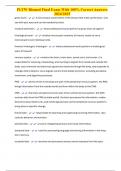PLTW Biomed Final Exam With 100% Correct Answers
2024/2025
gross exam - -a microscopic examination of the tissues that make up the brain. Can
see with your eyes and can be handled by hand.
medical examiners - -what professional would perform a gross exam of organs?
histological exam - -studies microscopic anatomy of tissues. needs to use a
microscope to see individual cells.
forensic histologist, histologist - -what professional would perform a histological
exam of tissues?
nervous system - -contains the brain, brain stem, spinal cord, and nerves. it is
responsible for receiving, interpreting, and reacting to signals from inside and outside the
body. uses chemical and electrical signals that transmit through the body, and responds to
changes that it detects. nerve signals control most bodily functions, including sensation,
movement, and digestive processes.
PNS - -all the nerves in the body are part of the peripheral nervous system. the PNS
brings information from the outside world and from within the body to the CNS.
CNS - -the brain and spinal cord are part of the central nervous system. the CNS
receives data from the PNS (outside world). the brain processes the information, makes
decisions about what to do, and sends signals back via the peripheral nervous system to
bring about a specific change.
frontal lobe - -responsible for planning and organizing incoming information. also
controls behavior and emotion.
parietal lobe - -crucial in integrating sensory and visual information.
temporal lobe - -used for processing language and storing information in the long-
term memory.
occipital lobe - -receives and processes sensory nerve impulses from the eyes.
, PLTW Biomed Final Exam With 100% Correct Answers
2024/2025
1)MRI(Magnetic Resonance Imaging)
2)Slices, Cross sections - -2 methods used in performing a gross exam of a brain
during an autopsy
TBI(Traumatic Brain Injury) - -a brain dysfunction caused by an outside force to the
head
CTE - -a progressive degeneration, and/or death, of nerve cells caused by repeated
head injuries, such as repeated concussions
cells - -basic unit for any organism such as a neuron that transmits information to
other cells
tissues - -composed of cells, and if relating this to nervous tissue it has both neurons
and cells, which senses stimuli and transmits signals
organs - -composed of tissue, for example, the brain is composed of nervous tissue,
which allows the brain to interpret stimuli
organ system - -composed of multiple organs, for example, the nervous system is
composed of all the organs in the nervous system, which is responsible for all activities in
the nervous system
epithelial tissue - -composed of epithelial cells aligned in sheets and connected to
one another. this tissue can be found lining the outer surfaces of all organs and blood
vessels, in the mouth, and on the surfaces of humans. this tissue works to absorb, secrete,
protect, and sense for us.
connective tissue - -supports and connects other tissue types in the body. different
types of connective tissue work to hold organs in place, attach muscle to bones, link bones
with joints, or enable other tissues (like lungs) to stretch. it is found attached to and in
between other tissues types in the body.
, PLTW Biomed Final Exam With 100% Correct Answers
2024/2025
nervous tissue - -nerves, the spinal cord, and the brain are composed of nervous
tissues. this tissue, made up of specialized cells called neurons, works to receive,
interpret, and respond to signals.
muscle tissue - -makes up the muscles found in the body. can be striated, smooth,
or cardiac
striated muscle - -also known as skeletal muscle tissue, is attached to bones;
voluntary
smooth muscle - -found in the walls of internal organs; involuntary
cardiac muscle - -found in the walls of the heart. this tissue provides the ability to
contract; involuntary
genome - -complete sets of genes within an organism, and genes are made up of
blood
blood is made up of 4 different bases which can create a variety. since genomes are genes,
genes are responsible for determining the cell structure and function by directing synthesis
of proteins and coding RNA molecules. - -how does a single genome code for so
many types of tissues?
concussion - -an injury to the head that causes the brain to quickly move back and
forth, hitting the inside of the skull.
they are stretched, sheared, or transected (cut into pieces). when an individual has
multiple severe concussions over their lifetime, a protein called tau forms clumps in the
brain. these proteins slowly spread throughout the brain and kill brain cells. - -what
happens to the neurons during a concussion?
vacant stares, disorientation, inability to focus, memory impairment, slurred speech, and
stumbling. may or may not involve a lot of consciousness. can heal within a few months. -
-what are the short term effects/symptoms of concussion?




